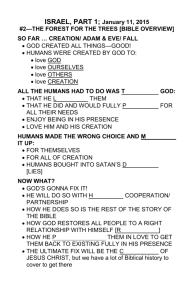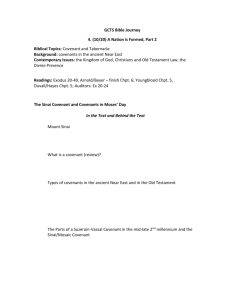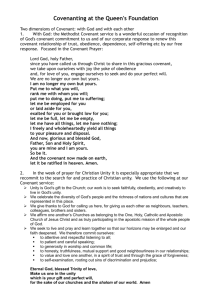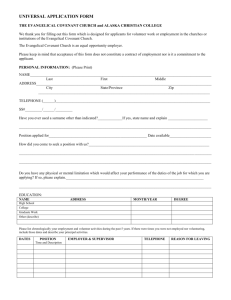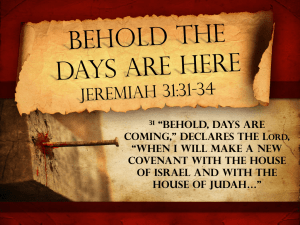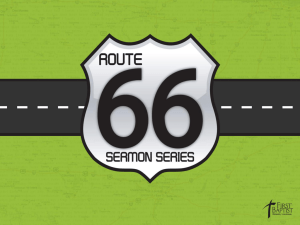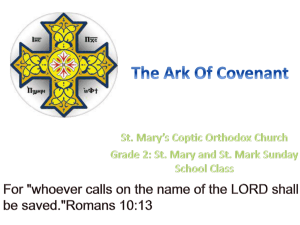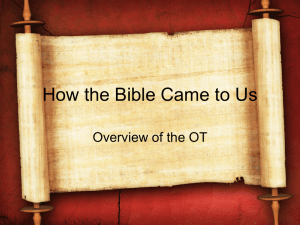Intro Study of Scripture Presentation
advertisement
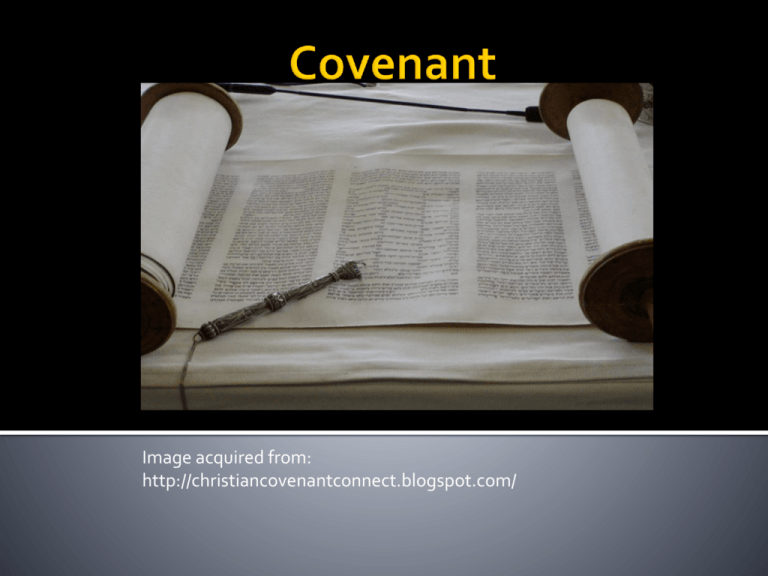
Image acquired from: http://christiancovenantconnect.blogspot.com/ A covenant is distinguished, “some scholars distinguish between "contract" (an exchange of goods and services) and "covenant" (an exchange of persons; for example in a marriage, or when Israel is called God's "firstborn son" in Exod 4:22)” (Just 1) “The Hebrew word that means “to swear a covenant” is based on the Hebrew word for seven. Someone who said “I swear a covenant” in Hebrew was literally saying “I seven myself.” (Hahn 45) “29 and Abimelech asked him, “What is the purpose of these seven ewe lambs that you have set apart?” 30 Abraham answered, “The seven ewe lambs you shall accept from me that you may be my witness that I dug this well.” 31 This is why the place is called Beer-sheba; the two of them took an oath there.” (GEN 21: 29-31; Nambra USCCB) “The name Beersheba means Beer (well) of the Sheba (Oath). Thus Scripture clearly displays the Number Seven with its associated meaning of Oath,” (McGough 1). First Covenant of Creation- “…in creating the world in seven days, God was swearing a covenant with the universe. He is not just the master, and we are not just slaves. He is more than creator, and we are more than his creatures. If God had stopped on the sixth day, we would be only creatures: we would be slaves and private property of God,” (Hahn 45). In reference to the Sabbath, “God invited us into that rest because that rest represents the covenant relationship that he established with his creation,” (Hahn 45). Image Acquired From: http://en.wikipedia.org/wiki/File:Michelangelo-creation.jp ADAM and Eve (Gen 1-2; although the word "covenant" is not used, some divine promises are made) NOAH and his Family (Gen 6-9) his descendants will be numerous and will become a great nation (12:2; 15:5; 17:20; 18:18; etc.) they will inherit the "promised land," later called the land of Israel (12:1; 15:18-21; 17:8; etc.) all other nations shall be blessed in him (12:3; 18:18) or through his offspring (22:18; 26:4) the "sign" of this covenant: the circumcision of all male descendants (17:9-14, 23-27; 21:4; etc.) MOSES and the Israelites (Exod 20-34; Deut 5-11) Life: God saves the family of Noah (6:18), telling them to be fruitful and multiply, and fill the earth (9:1, 7) Diet: they may now also eat animals, but may not eat/drink their blood, and may not shed human blood (9:2-6) Covenant: God promises not to destroy the whole human race again through a flood (9:8-11) the "sign" of this covenant: the rainbow set in the clouds each time it rains (9:12-17) ABRAHAM and his Descendents (Gen 12, 15, 17) Life on Earth: "Be fruitful and multiply; fill the earth and subdue it..." (1:28) Vegetarian Diet: "I have given you every plant... and every tree with seed in its fruit... for food" (1:29) Male and Female: "It is not good that the man should be alone" (2:18; cf. 1:27) Disobedience and Death: "...but of the tree of the knowledge of good and evil you shall not eat" (2:17) Monotheism: "Hear, O Israel: The Lord is our God, the Lord alone" (Deut 6:4; cf. Exod 20:1-3) Torah: the Law given on Mount Sinai, or Mount Horeb (esp. the Ten Commandments: Exod 20:1-17; Deut 5:1-21) Reciprocity of relationship: "I will be your God, you will be my people" (esp. Exod 6:7; Lev 26:12) the "sign" of this covenant: the stone tablets on which the Law is written (Exod 24:12; 31:18; etc.) DAVID and the Kingdom (2 Sam 7) God will establish forever David's "house" = the royal dynasty through his descendants (7:11-16) David's son (Solomon) will build God's "house" = the first temple of Jerusalem (7:4-7, 13) the "sign" of this covenant: the descendents of David (1Kings 1-3) and the temple itself (1Kings 5-8) All information on this slide taken from, “Just, Felix. "Covenants, Pillars, and Theologies in Ancient Judaism.” The "New" or "Renewed" Covenant: JEREMIAH The Lord will make "a new covenant with the house of Israel and the house of Judah" (Jer 31:31) God's Law will be within people, written on their hearts (Jer 31:34) This text is also quoted in the New Testament in Heb 8:8-12 JESUS At the Last Supper: "This cup that is poured out for you is the new covenant in my blood." (Luke 22:20; cf. 1 Cor 11:25) The Letter to the Hebrews calls Jesus "the mediator of the new covenant" (Heb 9:15; 12:24; see also 8:1-13) Paul also speaks of Christian leaders as "ministers of a new covenant" (2 Cor 3:6) All information on this slide taken from, “Just, Felix. "Covenants, Pillars, and Theologies in Ancient Judaism.” Image Acquired From: http://thepathlesstaken7.blogspot.com/2011/04/passiontidecommences.html “Literally, adherent of Herod, or of his dynasty,” (Buttrick 594). “In three unquestioned passages (Mark 3:6; 12:13=Matt. 22:16), the Herodians are mentioned as opponents of Jesus, along with the Pharisees,” (Buttrick 594). It is important to note that Matthew, for the most part, avoids the use of the term because of the difficulties associated with it. There is a lack of specificity among modern scholars as to which group is meant by this term. It is plausible that mostly it meant to describe those who supported the idea of a kingdom under Herod as opposed to the Roman procuratorship. (Buttrick 594) Image Acquired From: http://www.truthbook.com/index.cfm?linkID=171 “Publican, in the Gospels, is derived from the publicanus of the Vulgate, and signifies a member or employee of the Roman financial companies who farmed the taxes,” (Driscoll 1). The best example of a Publican in the Holy Scriptures is the parable with the Pharisee. “[11] The Pharisee standing, prayed thus with himself: O God, I give thee thanks that I am not as the rest of men, extortioners, unjust, adulterers, as also is this publican. [12] I fast twice in a week: I give tithes of all that I possess. [13] And the publican, standing afar off, would not so much as lift up his eyes towards heaven; but struck his breast, saying: O God, be merciful to me a sinner. [14] I say to you, this man went down into his house justified rather than the other: because every one that exalteth himself, shall be humbled: and he that humbleth himself, shall be exalted,” (Lk 18: 11-14; Douay-Rheims). “In the Gospel’s Jesus has many encounters with the publicans. These encounters can only be found in the synoptic Gospels. Jesus’ association with the publicans is viewed as showing the message of God’s mercy to sinners. Zachues was one of the tax collectors Jesus associated with. He was a chief publican at Jericho. Apparently he had other publicans underneath him. Mathew was also a tax collector. He was one of the inferior publicans,” (Freedman 1). Image Acquired From: http://www.glendorachurch.com/articles/2011/07-23-11.htm “It was the Assyrians that destroyed the northern kingdom Israel under Shalmaneser IV who besieged Samaria and then died during the siege leaving Sargon II to finish the task and drag Israel into captivity. After defeating the northern kingdom of Israel in 722 B. C., the Assyrians carried away thousands of Israelites and resettled them in other parts of the Assyrian Empire. This was a blow from which the nation of Israel never recovered. The ten tribes that were taken to Assyria became the ten lost tribes, for they have never again emerged in world history,” (The Old 1). Image Acquired From: http://www.mst.edu.au/course_outlines/183Lesso n01.html The Seleucids were a group of people living under the Hellenistic rule of one of Alexander the Great’s generals and his successors throughout Asia Minor. (Buttrick 264) Seleucia, a free city under the Romans, was the site of several early Christian journeys. Many evangelists passed through on their way to the sea. (Buttrick 266) Image Acquired From: http://bibleillustration.blogspot.com/2008/09/bibleanimals.html “The Lord Jesus speaks of foxes in Matt 8:20, and dogs in Luke 16:21, He also mentions sparrows in Matt 10:29-31. Pigs, deer, owls and goats are all also mentioned in the Bible, as is the rock badger in Psalm 104:18,” (The Bible 1). “Although no regular classification is to be sought for in the Bible, it is easy to see, however, that the animal creation is there practically divided into four classes, according to the four different modes of locomotion; among the animals, some walk, others fly, many are essentially swimmers, several crawl on the ground,” (Souvay 1). “The first class, the behemôth, or beasts, in the Biblical parlance, includes all quadrupeds living on the earth, with the exception of the amphibia and such small animals as moles, mice, and the like. Beasts are divided into cattle, or domesticated (behemoth in the strict sense), and beasts of the field, i.e. wild animals. The fowls, which constitute the second class, include not only the birds, but also "all things that fly", even if they "go upon four feet", as the different kinds of locusts. Of the many "living beings that swim in the water" no particular species is mentioned; the "great whales" are set apart in that class, while the rest are divided according as they have, or have not, fins and scales (Leviticus 11:9, 10). The reptiles, or "creeping things", form the fourth class. References to this class are relatively few; however, it should be noticed that the "creeping things" include not only the reptiles properly so called, but also all short-legged animals or insects which seem to crawl rather than to walk, such as moles, lizards, etc. From a religious viewpoint, all these animals are divided into two classes, clean and unclean, according as they can, or cannot, be eaten,” (Souvay 1). Hahn, Scott, and James Socías. Understanding the Scriptures. Woodridge, IL: Midwest Theological Forum, 2010. Print. “Genesis.” United States Conference of Catholic Bishops. N.p., n.d. Web. 16 Nov. 2012. <http://www.usccb.org/bible/genesis/21>. McGough, Richard A. "The Number Seven and Scripture." The Number Seven and Scripture. N.p., n.d. Web. 16 Nov. 2012. <http://www.biblewheel.com/topics/seven.asp>. Just, Felix. "Covenants, Pillars, and Theologies in Ancient Judaism." Covenants, Pillars, and Theologies in Ancient Judaism. N.p., n.d. Web. 16 Nov. 2012. http://catholic-resources.org/Bible/Covenants.htm. Buttrick, George Arthur. The Interpreter's Dictionary of the Bible; an Illustrated Encyclopedia Identifying and Explaining All Proper Names and Significant Terms and Subjects in the Holy Scriptures, including the Apocrypha, with Attention to Archaeological Discoveries and Researches into the Life and Faith of Ancient Times. New York: Abingdon, 1962. Print. Driscoll, James F. "Publican." The Catholic Encyclopedia. Vol. 12. New York: Robert Appleton Company, 1911. 11 Dec. 2012 <http://www.newadvent.org/cathen/12553d.htm>. "Douay-Rheims Catholic Bible." Douay-Rheims Catholic Bible. N.p., n.d. Web. 12 Dec. 2012. "The Old Testament - A Brief Overview." The Story of the Bible: The Assyrians. N.p., n.d. Web. 2 Dec. 2012. Freedman, David N., The Anchor Bible Dictionary. New York: Doubleday Dell Publishing Group, Inc, 1992. Vol. 5,6. "The Bible Illustration Blog." The Bible Illustration Blog. N.p., n.d. Web. 1 Dec. 2012. Souvay, Charles. "Animals in the Bible." The Catholic Encyclopedia. Vol. 1. New York: Robert Appleton Company, 1907. 12 Dec. 2012 <http://www.newadvent.org/cathen/01517a.htm>.
